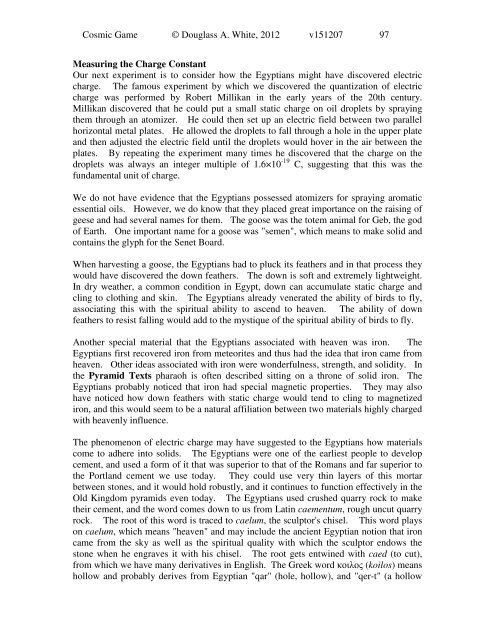You also want an ePaper? Increase the reach of your titles
YUMPU automatically turns print PDFs into web optimized ePapers that Google loves.
<strong>Cosmic</strong> <strong>Game</strong> © Douglass A. White, 2012 v151207 97<br />
Measuring the Charge Constant<br />
Our next experiment is to consider how the Egyptians might have discovered electric<br />
charge. <strong>The</strong> famous experiment by which we discovered the quantization of electric<br />
charge was performed by Robert Millikan in the early years of the 20th century.<br />
Millikan discovered that he could put a small static charge on oil droplets by spraying<br />
them through an atomizer. He could then set up an electric field between two parallel<br />
horizontal metal plates. He allowed the droplets to fall through a hole in the upper plate<br />
and then adjusted the electric field until the droplets would hover in the air between the<br />
plates. By repeating the experiment many times he discovered that the charge on the<br />
droplets was always an integer multiple of 1.6×10 -19 C, suggesting that this was the<br />
fundamental unit of charge.<br />
We do not have evidence that the Egyptians possessed atomizers for spraying aromatic<br />
essential oils. However, we do know that they placed great importance on the raising of<br />
geese and had several names for them. <strong>The</strong> goose was the totem animal for Geb, the god<br />
of Earth. One important name for a goose was "semen", which means to make solid and<br />
contains the glyph for the Senet Board.<br />
When harvesting a goose, the Egyptians had to pluck its feathers and in that process they<br />
would have discovered the down feathers. <strong>The</strong> down is soft and extremely lightweight.<br />
In dry weather, a <strong>com</strong>mon condition in Egypt, down can accumulate static charge and<br />
cling to clothing and skin. <strong>The</strong> Egyptians already venerated the ability of birds to fly,<br />
associating this with the spiritual ability to ascend to heaven. <strong>The</strong> ability of down<br />
feathers to resist falling would add to the mystique of the spiritual ability of birds to fly.<br />
Another special material that the Egyptians associated with heaven was iron. <strong>The</strong><br />
Egyptians first recovered iron from meteorites and thus had the idea that iron came from<br />
heaven. Other ideas associated with iron were wonderfulness, strength, and solidity. In<br />
the Pyramid Texts pharaoh is often described sitting on a throne of solid iron. <strong>The</strong><br />
Egyptians probably noticed that iron had special magnetic properties. <strong>The</strong>y may also<br />
have noticed how down feathers with static charge would tend to cling to magnetized<br />
iron, and this would seem to be a natural affiliation between two materials highly charged<br />
with heavenly influence.<br />
<strong>The</strong> phenomenon of electric charge may have suggested to the Egyptians how materials<br />
<strong>com</strong>e to adhere into solids. <strong>The</strong> Egyptians were one of the earliest people to develop<br />
cement, and used a form of it that was superior to that of the Romans and far superior to<br />
the Portland cement we use today. <strong>The</strong>y could use very thin layers of this mortar<br />
between stones, and it would hold robustly, and it continues to function effectively in the<br />
Old Kingdom pyramids even today. <strong>The</strong> Egyptians used crushed quarry rock to make<br />
their cement, and the word <strong>com</strong>es down to us from Latin caementum, rough uncut quarry<br />
rock. <strong>The</strong> root of this word is traced to caelum, the sculptor's chisel. This word plays<br />
on caelum, which means "heaven" and may include the ancient Egyptian notion that iron<br />
came from the sky as well as the spiritual quality with which the sculptor endows the<br />
stone when he engraves it with his chisel. <strong>The</strong> root gets entwined with caed (to cut),<br />
from which we have many derivatives in English. <strong>The</strong> Greek word κοιλος (koilos) means<br />
hollow and probably derives from Egyptian "qar" (hole, hollow), and "qer-t" (a hollow





